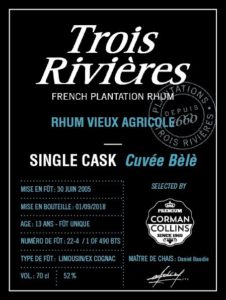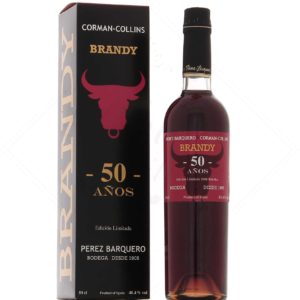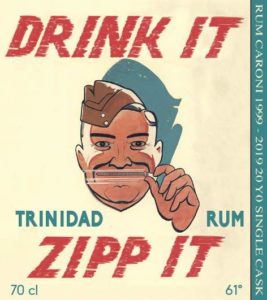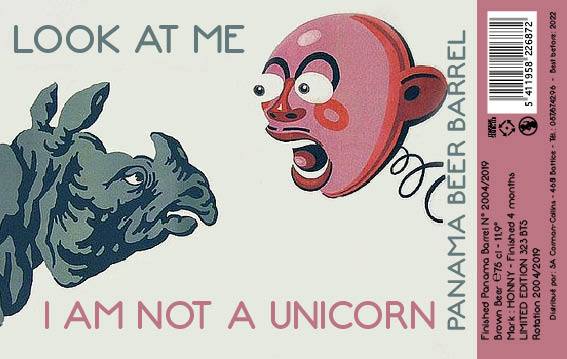
The arrival of Corman Collins bottlings on the site is an opportunity for us to discover their creator, Hubert Corman . This essential character from across the Quiévrain has been immersed in spirits for several decades and certainly has a lot to tell us. But first, let's let him introduce himself:
Hubert Corman , originally from Battice in Belgium , born on February 21, 1969. General administrator of SA Corman-Collins . Corman-Collins was founded in 1965 by Hubert Corman [editor's note: therefore Hubert's father] and Marie Jeanne Collins.
Initially, it was a door-to-door sales activity for fresh products. Over time, drinks were added: water, beers, wines and spirits. In the early 80s, we opened our first shop specializing in beers with 400 references in wines and spirits. At that time, we were already selling rums, whiskies, etc.
In 1992, we moved to our new space on a 6000 m2 plot with office, storage shop, warehouse and parking.
Where does this passion for spirits come from, and when did it start?
I was lucky because at the time of our first shop, we had a wide choice of spirits and I was always attracted by Scotland, its history, its landscape. There was a bottle of vintage Glenmorangie on the shelf. It had been catching my eye for a while and one day I cracked, I must have been 20 years old. That same evening, I went to an uncle's house and we tasted this Glenmorangie together. Spirits have never left me since.
Initially very whisky , because our luck in Belgium at that time was that there were large distribution houses like Fourcroy Renglet – Cinoco – UDV – Bols Interbrands etc… They had in their catalogue Bowmore, Gordon MacPhail, Bunnahabhain , Glen Garioch, Macallan, Balvenie , Auchentoshan, Ainslies, Lagavulin and a good number of distilleries.
In 1980, very few offered rums, the classics being Saint James, Trois Rivières, Negrita, Charleston, Appleton and the GDC label rums and others. It was from the 90s that things started to move, we found a wider selection, often from Martinique. Very few other origins, it was not easy at that time to find a ron from Venezuela, El Salvador or that part of the world.
Samaroli , Bally, Bristol, Chantal Comte, Velier, no one wanted it, because rum often had a bad image. Cooking, baking, or grog – rum remained compartmentalized in these categories for a long time. It was often only during blind tastings that a few amateurs and curious people became interested in distilled cane juice .
Often coming from the world of whiskies , the amateur is actually looking for a similar taste sensation. And initially to reassure them during this sometimes complicated passage, we presented the agricultural or the aged Jamaican .
I believe you are also a great collector, do you have any favorite areas? (eras, regions, distilleries, etc.)
Acute collectionitis is an addictive virus with no particular cure.
Having grown up in a beverage business, I was in contact with old bistros and breweries very early on. So naturally my first big collection was enamel signs, jukeboxes, pinball machines, counters and advertising objects. My warehouse was bursting at the seams, until the 2000s. Then, as is often the case, you have to make the decision to make room and sell some of it, and devote yourself to a less invasive collection (sic)...
Our status as an importer and bottler at the time opened many doors for us. This period was also easy because everyone knew each other and resold their bottlings easily. Naturally and because the quality of the bottlings was incredible. Bottles, cases of 6, were kept with initially no idea of the prices that some bottles could reach today.
We only keep bottles that have a very high taste quality, without a preferred region or origin, and even less so a distillery special. For the whiskeys I'm really a fan of the very old ones Lowlands, old traffic jams from the 50s/60s/70s.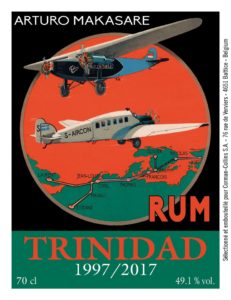
Old traffic jams contain a history , an era, a style, which today will never be reproduced. While today's traffic jams are certainly of good quality, before there was something that hit the mark.
It is this aspect that makes us vibrate, opening an old bottling is like turning the pages of a book backwards to discover the title.
How many times when opening these old pins have we not said wow!!! On a West Indies Samaroli, Appleton 20 yo Ceramic Jug, a Bally 1944, Caroni 1974 Bristol , Courcelles 1948, Uprana 54°, and many others. Passion also only comes when there is pleasure and sharing , not necessarily between amateurs but also with newcomers who seek to discover.
When it comes to rums, what style(s) do you prefer?
We taste a lot of things and really research quality, elegance, balance, finesse, whatever the origin or style. The favorite like our Bally 18 years or the Caroni Zipp IT -Drink IT, that's our motivation. We like to share this with our friends, customers, fans around the world.
Arturo Makasare is a range from the Dominican Republic, each bottling is unique and comes from a single barrel that we select with our local partners. The entire aging is done on site, “ Tropical ”. The reduction is also done on site, only the bottling is done in Belgium at our partner.
Regarding the Trois Rivières cuvée Bèlè, what did you try to highlight in the work of this house?
For this Bèlè vintage from Trois Rivières, Daniel Baudin and I tasted the samples he had prepared for us. The last sample was for me the one that brought together all the parameters I wanted for our own selections.
There was a happy medium between woody, tobacco, chocolate, and vegetal. Then there is the cultural aspect that we particularly like. Let's avoid once again the clichéd side of Aimé Césaire or Madras. Creole culture being strong locally, it is not exported much. I wanted to highlight Bèlè because music and dance are timeless and unifying. By wanting to illustrate our packaging of this vintage with a dancer, the trick was done.
For the navy blends, can you reveal the information on the rums present in the blend?
It's confidential.
Can you tell us the story of the Dame-Jeanne traffic jams?
The Dame Jeanne bottlings come from “ Dames Jeanne ” in our collection. They date from the 70s and unfortunately do not have any mention of age or distillery. Both have quite different profiles and degrees.
These two Dame Jeannes were not in good shape and to avoid losing them completely, we decided to open them and taste them to see if the rum was still of good quality.
The degree itself had not changed after all these years.
Then, the goal is to be able to still introduce old rums from this era at a very reasonable price.
How do you select the oldest Bally ever bottled?
Between the idea and the realization two years ago. The meeting with Simon Pierre at a trade fair at the corner of a stand between three tastings and a few slightly busy wine merchants :o)
Then for almost a year nothing happens…
We are organizing a tasting evening in our store on the theme of “ Depaz ” with Benoit Bail and Jerry Gitany as speakers, accompanied by Simon Pierre.
The evening ended with a huge Old Speyside 1966, then things got going more quickly. The selection included 3 samples, all of a very very high level, each deserving a bottling, but we had to choose one!! So we had to find a fault or a criterion for not selecting it!! This 2000 had really left its mark on us and with my friend Roger Caroni from Roger's blog there was a "F... M... that's really good!!!". And it's actually this 2000 that I kept.
The other side of this project is also being able to create the packaging and add our personal touch. As we did for the 3 Rivières cuvée Bèlè.
We would like to thank once again all the people who contributed directly or indirectly to finalizing this project, to make it today the oldest bottled Bally rum.
How did you come to bottle this brandy at this considerable age?
It's a long story. To make it short:
About ten years ago, a very bad friend offered me a bottle of Brandy bottled for La Bota in Spain . He knows me well and knows that I will like it, well seen!!!
Except that this bottle is only bottled at +/- 400 bottles. It is number 13 in the series and is already completely sold out so finding a second one is tough.
A decade goes by and a listing of very old PX from a bodega in Andalusia arrives on my desk. One thing led to another, we talked and this person suggested I meet one of his friends located not far from this Bodega.
Rafael offers me his wines, explains his Bodega and their activities. We quickly meet again but in Belgium to develop the wines of Montilla Moriles .
In our facilities, he discovers our universe, I ask him if he knows La Bota and their work. He is surprised that I know this house.
How could we work on brandy together he said to me? "Well if you find me in your stocks the same profile as this La Bota N°13 we will do a very good job together!" "Where did you get this bottle from?" Because in fact this version was intended for the Australian market! "Um it's a gift!!"
In short, 3 weeks later I received the first samples of the last 50 year old barrels . The bottling yielded 1008 bottles at 40.4°.
This Brandy is certainly the best Brandy I know along with La Bota's No. 13.
You have seen rum evolve enormously in recent years, how do you see things for the years to come?
This is a big question.
We are in a time of globalization where houses and brands are no longer concentrated in Europe, as they were 20 years ago. New economic players have arrived. Their markets are sometimes still weak, but this will only increase.
The consolidation of brands following acquisitions further consolidates this expansion.
There are the small ones who have difficulty existing and the big powerful ones who are unfolding. Sometimes they do not always understand that they are complementary as much by their activities as by the understanding of the market and its consumers who have become demanding .
These are cycles. Today, look, even large groups buy small houses or brands, because they need to do artisanal work to give themselves a nice image with consumers.
Then there is the rise in prices for many products without increasing in quality. Gone are the days when you could buy dozens of bottlings at reasonable prices and of splendid quality, rums and whiskies combined. All without exception have positioned themselves in this gap, forgetting in the process all the work of the true connoisseur who has largely contributed to the success of spirits and who today, due to this surge, can no longer or no longer wishes to buy them.
The houses forget this, but when the wind turns it will be very very complicated to go back. Today for most of these premium , limited, single cask products, stamped blah blah, more than 50% have not been opened or consumed. They are just boxed up not by amateurs but just by speculators who through this practice contribute to increasing public prices during new releases.
With the standardization of products, taste, tight stocks, new markets, it is not interesting for big brands that small ones exist, because they offer something else. And even if they do not need it strategically, taste-wise it is another story. If the consumer can discover something else (style, taste, history, etc.) there is a chance that he will leave his habits and comfort zone for less smooth products. Which does not suit multinationals. What they want is to make people consume a brand and not a product!!!!
Sometimes we might be glad that a Brexrum or Whisxit is happening.
